Siena, the Gothic City 🇮🇹
Our next destination was Siena, a medieval city adorned with Gothic structures. During our walking tour, we marveled at the city's beauty and fascinating history and culture. It was a nice start for our Tuscan Country tour, setting the pace and mood for the rest.
Though Siena is, by now, reduced into a small city, barely inching up from its 50,000-population during its heyday, it is by no means an ordinary town. It remains grand and special in so many ways.
En Route from Florence
 |
| Mama Sarah and I just behind the Train Station as we waited for our bus. |
Our Tuscan Country tour began just outside the Santa Maria Novella Train Station in the middle of a huge piazza in Florence. We waited for our bus, which would take us to our next destinations - Siena, San Gimignano, and Pisa.
Davide, the tour guide, was punctual even though he lost his voice due to drinking and partying the night before. But beware, Davide was austerely punctual - he gets cranky when somebody arrives late, regardless of the reason, whether valid or not (he doesn't care).
It didn't matter to us though as we enjoyed the trip nevertheless. Davide, if you're reading this article, I didn't say your name was "Giovanni"!
The Tuscan Countryside
 |
| Just one of the idyllic sights of rural Tuscany |
From our seats on such a comfortable bus ride, we saw the Tuscan countryside. I would say the views were pretty much the same all throughout, with little to no variation - rolling hills, pencil pines, prairies of auburn brown and verdant green, imposing castles, and huge manors.
I honestly felt a little bored at the lack of variety, but at the same time amazed at how organized and uniform everything was. I like sight-seeing when on sojourn and I often notice that the sights along the way are usually just as fascinating as the destinations. However, in Italy, sight-seeing seemed like a waste of time, for the destinations themselves wowed me at every turn. It seems that their grandness makes everything else unremarkable.
Arrival
The moment we hopped off our bus, we instantly saw ancient structures that caught our attention. The city walls of Siena were huge that I was unable to compare it to Manila's Intramuros. Though the latter undeniably has its own charm, beauty and appeal, Siena's walls were something I have never seen before.
 |
| The demarcations of Siena's ancient borders were delimited by huge walls |
 |
| Greens everywhere |
The city walls were built between the 14th and 16th Centuries, during its golden age, before it was defeated by Florence in an intense centuries-long rivalry that ended in 1555.
The fall of this medieval city began in 1348, during the height of the Black Plague. Since then, the city has not recovered. Its current population - 50,000 - is just a little higher than its mid-14th Century size. Regardless, the city remains magnificent with many of its centuries-old buildings still intact.
City Tour
 |
| Mama Sarah and my sister pausing for pictures |
We enjoyed the walking tour of the city's cobbled streets. Like anywhere else in Italy's tourist destinations, every corner was instagram-worthy that it's close to impossible to deselect even a single picture, so I just decided to create a simple gallery below.
 |
The Oldest Bank in the World
On our walking tour, we passed by what is said to be the oldest bank in the world. The signage says it was established in 1472, making it five and a half centuries old! It survived several economic crises. Even with the Fall of Siena, it continued to operate. The wars left it unscathed. Now, in the middle of the 21st Century, it is standing tall and proud as the oldest in the entire world.
The Palio & the Animal Emblems
 |
| Istrice (Crested Porcupine), the smallest contrada of Siena. |
We passed by quirky animal emblems all over the city and wondered what they were for. The tour guide told us that Siena is divided into 17 districts (also known as "contradas") represented by animals. Each district competes for the Palio or the bi-annual horse-racing competition of Siena. There are several Palios all over Italy and the rest of Europe, but the most famous and the longest-running is the version of Siena.
 |
| Bruco (Caterpillar) |
The Palio is held at Piazza del Campo, the main public square of Siena, where jockeys ride horses bareback and circle the Piazza on three lapses. Sometimes, jockeys are thrown off their horses riderless, but the districts they represent could still win as it is not required for the horses to have riders to win the race.
As long as the horse finishes the race first, even without the rider (which appears to be reduced into a mere "chattel"), the district it represents wins.
 |
| The Piazza del Campo |
Among the 17 emblems was a very familiar animal - the she-wolf. When we were doing the walking tour, I honestly thought the tour guide was mistaken. The she-wolf suckled by the twins Remus and Romulus is an animal too famous that it might have had a bigger role in the city. However, after confirming online, it is indeed one of the seventeen districts!
 |
| Lupa (She-Wolf) |
Legends say that Siena was founded by Senius and Aschius, sons of Remus, the twin brother of Romulus, the founder of Rome. Because of Siena's strong connections to the founding of Rome - basically a family branching out to another - the two cities have a sisterhood pact.
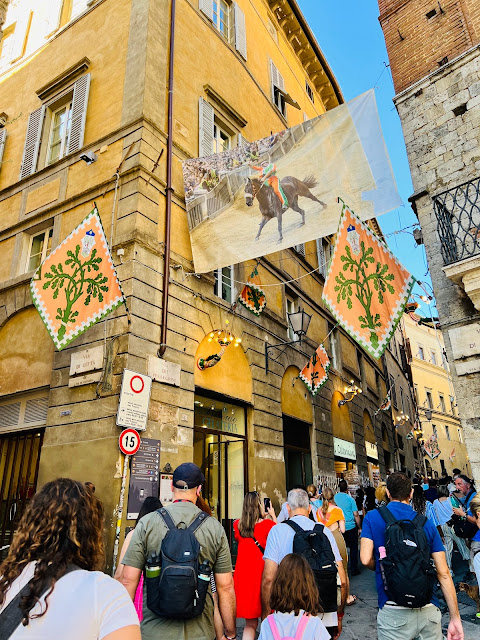 |
| The winning contrada, Selva (Forest), proudly waving their flags. |
Selva (Forest) was the winner of the July 2023 Palio so its residents proudly displayed their flags on the streets. Selva is represented by the rhinoceros.
 |
| Rhinoceros, the animal emblem of Selva. |
The animal symbols that represent each district have long, complicated histories with heraldic and semi-mythological associations. Sadly, the walking tour was too short, we didn't hear the "crazy" backstory behind each symbol.
The Grand Duomo di Siena
The pinnacle of our Siena walking tour was its magnificent cathedral. We were given an hour to explore this beautiful ancient structure, which covered the bulk of our walking tour.
The Duomo di Siena was constructed from 1215 to 1263 and was designed in Gothic Architectural Style, the predominant style during the latter part of the Medieval Age.
The facade's intricate details did not amaze me as Milan Cathedral's facade was far more complex, but what lies within was a pleasant surprise that justified my sister's decision to include Siena in our European Escapade.
Impressive Interiors
Walking inside the cathedral was a jaw-dropping incident for me. The first thing I noticed were the pillars that looked like zebra stripes, alternating between black and silver, which contrasted nicely with the shining golden dome.
Everything was literally well-polished, shining radiantly as though the cathedral was brand new even though it has been standing for nearly eight centuries.
 |
 |
| Myself, happy inside. |
Piccolomini Library
Inside the cathedral was a library named after a Siena native, Pope Pius II, whose real name was "Enea Silvio Piccolomini." The library was small, just about a hundred square meters large, but it contains magnificent frescoes that date back to the beginnings of the 16th Century.
Untouchable. The books are only for eyes to see. They need to be preserved so that generations of the future will see them.
 |
| Obligatory Selfie |
The Allegory of Wisdom
The cathedral was laden with marble mosaic floor depicting so many stories, some of which come from the Old Testament. One of them was the "Allegory of Wisdom." According to the tour guide, this part of the floor is only visible in the month of September but it is covered for the rest of the year.
It tells the story of how Wisdom is invaluable while Riches run out. What one learns from experience can be used for the rest of one's life.
The Rest of the Cathedral
There's so much to see but so little time. The tour guide simply gave us a brief overview of the cathedral, but it has so many fascinating stories to tell, accumulated through centuries, even millennia, as some of the stories date back to the ancient times.
The grandeur of the cathedral does not depend on its appearance alone, but on the historical value of each and every piece of structure or painting you will see inside.
Epilogue
Our Siena walking tour lasted for less than three hours --- short, but filled with so many details and experiences that I will remember for the rest of my life.
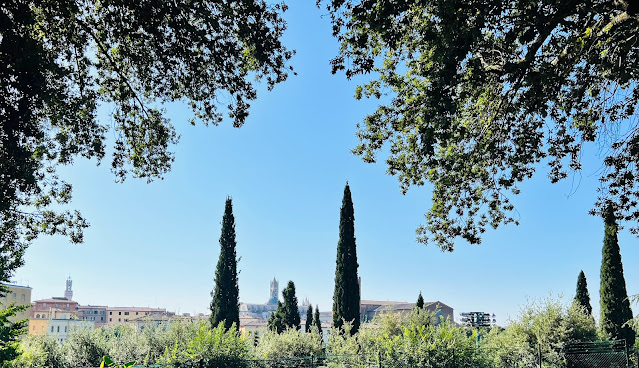

























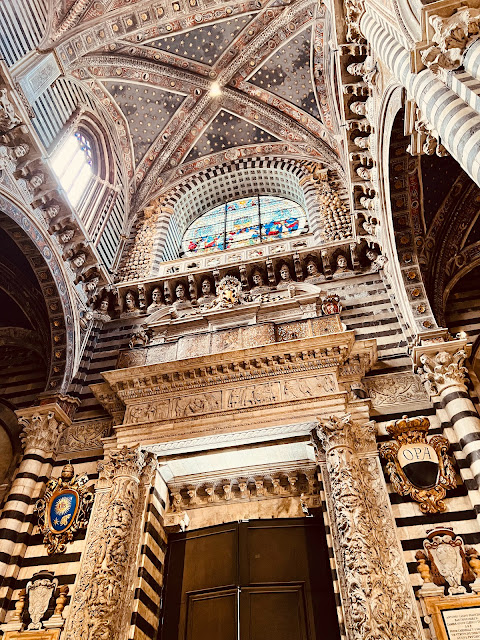



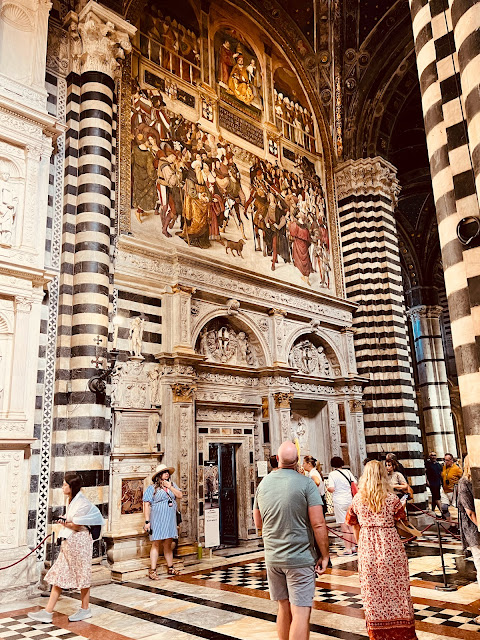











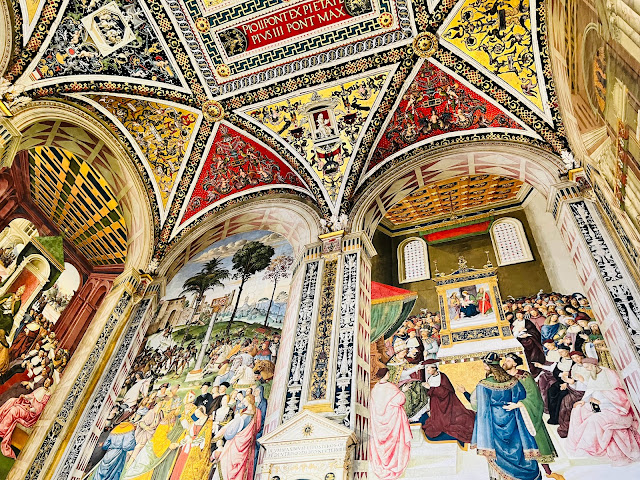



























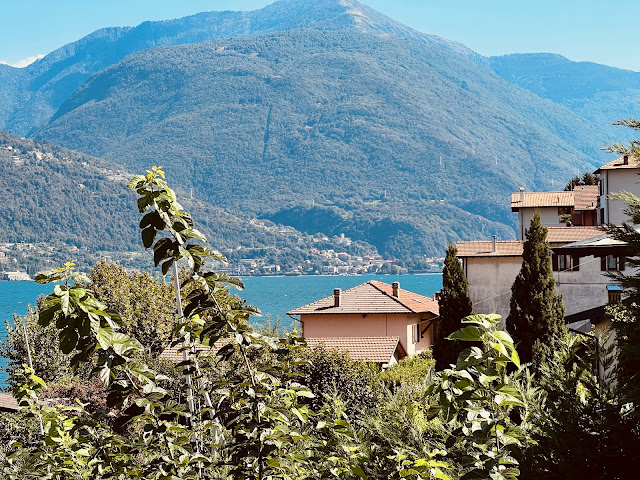
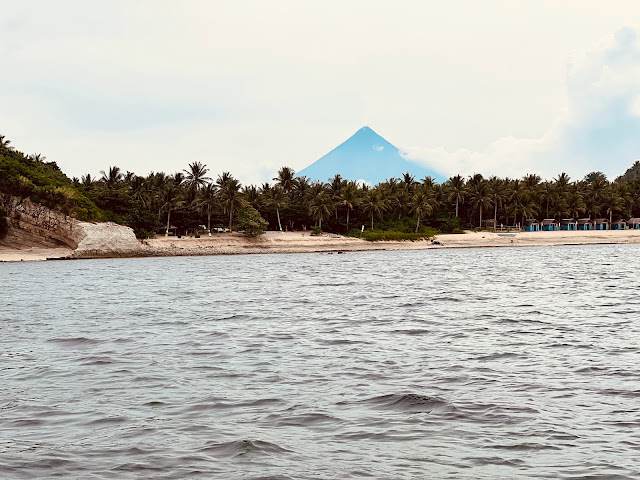
Comments
Post a Comment